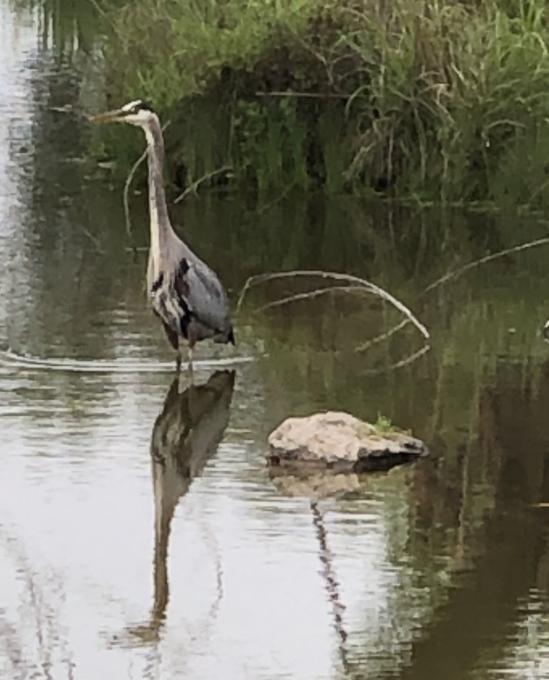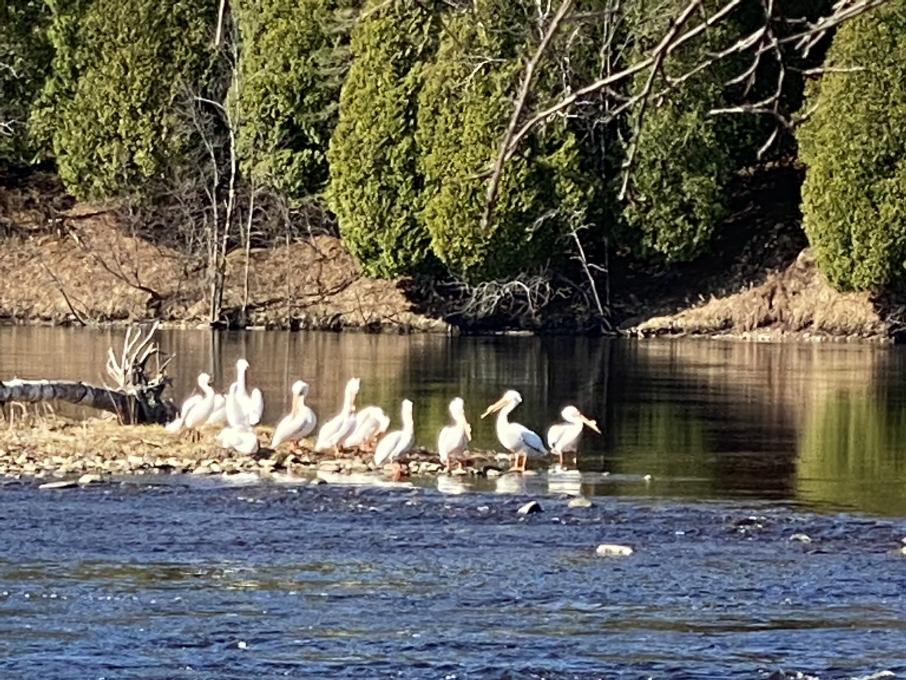The Cornell Lab Bird Academy › Discussion Groups › Joy of Birdwatching › Activities: Bird ID Practice
-
 Bird ID Activity 1: This is a photo from last year just after I got my 40-150 sense for Olympus. I think this is a coopers hawk from my previous searches through the bird guides that I have. It is a juvenile that I saw hunt in the neighborhood a few times. A feature not captured in a photo is its fan shaped tail that appears white with black stripes, ie the white is 50% broader than the black on the tail. Merlin from my descriptions suggests a red shouldered hawk is more likely in Florida.
Pertinent to this exercise though, another bird hunts in the neighborhood as well. It is a little smaller with a long forked tail. It is a swallow tailed kite. I don't have a good picture but once you have seen one fly nearby, it is impossible not to recognize.
Bird ID Activity 1: This is a photo from last year just after I got my 40-150 sense for Olympus. I think this is a coopers hawk from my previous searches through the bird guides that I have. It is a juvenile that I saw hunt in the neighborhood a few times. A feature not captured in a photo is its fan shaped tail that appears white with black stripes, ie the white is 50% broader than the black on the tail. Merlin from my descriptions suggests a red shouldered hawk is more likely in Florida.
Pertinent to this exercise though, another bird hunts in the neighborhood as well. It is a little smaller with a long forked tail. It is a swallow tailed kite. I don't have a good picture but once you have seen one fly nearby, it is impossible not to recognize.
-
Activity one: the black headed grosbeak and the hooded oriole are the two birds in my yard I used for comparison. They are very similar in color but the grosbeak has a much broader beak than the oriole. The body is also slimmer on the grosbeak and more rounded on the oriole. activity two: I had a woodpecker in my backyard that does not come up in the app for my location. The markings are most similar to a yellow bellied sap sucker. I have also found a picture of a red naped sapsucker that is also very similar. It was definitely not the hairy woodpecker or the ladder-backed woodpecker that came up in the app. Activity three: the roofers hummingbirds search for food among the flowering shrubs in my backyard. The spotted towhee hops around in the grass, and the Woodhouse you activity three: the roofers hummingbirds search for food among the flowering shrubs in my backyard. The spotted towhee hops around in the grass, and the Woodhouse’s scrub jays prefer the suet over the birdseed. activity four: hooded oriole, Size is between a sparrow and a robin, shape is rounded like a robin, black mask and bib, bright orange head and chest, black wings with white bars. Beak is dark, narrow, and slightly curved.
-
I have just begin birdwatching casually, so just observing whoever may be passing through the front or back yard, so I will be a bit flexible with my responses: Activity 1: I can tell apart Common Grackles and Robins by shape as the grace is less rotund and has a more striking tail. Activity 2: I have identified Common Grackles, Cardinals, and Red Wing Blackbirds as three birds that have black coloring. The grackle has it as an eye ring and pupil, the blackbird is almost wholly black except for the patch of red, and the northern cardinal has a black mask behind its beak. Activity 3: I have seen morning doves, robins, and song sparrows prospecting amongst the lawn for something to eat, whether insect or seeds I could not tell. Activity 4: It's tough to pin down a favorite, but I think my favorites are the most uncommon for me to observe casually, whether Orioles, Mockingbirds, or Merlins. I'll describe the Orioles because the first time I saw them was yesterday; they appeared to be mating or competing for a mate by hopping from tree limb to tree limb. They appeared to be feeding at flowers on a nearby shrub, and they featured very striking and easily discernible colors with an orange breast and black upper body and white wing flashes.
-
Activity 1: When I first began feeding birds, I had lots of small brown birds which I assumed were all wrens. I soon realized that most were actually sparrows. I first used characteristics of shape to separate the wrens from the sparrows: the wrens' tail position (cocked up) and their longer, curved beak. I can now use color as well, but I am still trying to figure out all the striping patters on the sparrows! Activity 2: We'd gotten used to seeing downy woodpeckers, so we did a double-take when the first red-breasted grosbeak appeared. The black and white and red colors are striking! I don't think we've seen hairy woodpeckers or red-headed woodpeckers in our yard so far this year, but I'll be watching for them. One day this year I had three brown birds in the yard, on the ground, at nearly the same time: a wren, a thrush and a thrasher. It was a bit like small, medium and large. I haven't seen the thrush again, but the other two are reliable visitors. Activity 3: Just today I've seen the mourning doves waddling across the ground looking for seeds, the black-capped chickadee visiting quickly to grab a seed to carry away, and a gray catbird lingering at the feeders to peck at cranberries and the grape-jelly topped orange half. Activity 4: In the previous lesson I said that nuthatches were my favorite and that I primarily used their behavior (climbing down head-first) to identify them. Their lovely bluish-gray, black and white coloring distinguishes them from the other smallish birds. Their profile differs distinctly from the tufted titmouse which is similar in size and color.
-
Activity 4 Favourite Bird White-crowned Sparrow. My favorite bird is always my last “best” bird. They can be the best because they are rare, they can be the best because it is the first time I have ever seen one, and they can be the best because it is the first time that I confidently and correctly identified them myself for the first time. That happened to me today (May 1, 2020) with a White-crowned Sparrow that was fleetingly at my feeders. I find sparrows challenging, and I have been working on them, so this was a bit of personal achievement for me. White-crowned sparrows are sparrow sized and shaped; not unusually large or small. They are a grey and brown bird with a clear grey breast and bold white and black stripes on their heads, like a bicycle helmet. They are ground foragers and tend to the forest edges and scrub areas. They can winter in my area which is far south-western Ontario near the Detroit River, but they breed up in the far north boreal forest. So this guy was going somewhere when he stopped briefly at my backyard feeder.

-
Activity 3 3 Birds Foraging Behavior American Robin, House Sparrow, Mourning Dove. I list these 3 birds because they are in my backyard regularly and have very different foraging behaviors. Only the House Sparrow feeds directly from the feeders. The Mourning Doves forage from the ground. The Robins never come near the feeders but hop about on the grass or in the gardens looking for insects at this time of year.
-
Activity #2 3 birds the same colour Chipping Sparrow, American Tree Sparrow, Field Sparrow. These are three little brown birds that take some practise to separate in the field. All three are rufous brown, grey, and black. All three have unstreaked breasts, rufous crowns, and eye-stripes, so you have to remember to carefully note the important features as these little birds bounce about. Here is what I look for American tree sparrow: bi-colored bill, black spot on the chest Chipping sparrow – no spot, white supercilium and brown eyeline Field Sparrow – pink bill, light colored legs, slightly white eye-ring, generally “pink and buffier” than the American tree, and Chipping Sparrows. American Tree Sparrow
 Chipping Sparrow
Chipping Sparrow
 Field Sparrow
Field Sparrow
-
Thank you for those helpful observations!!!
-
-
Activity #1 2 Birds by shape Red-winged Blackbird and Common Grackle. Both of these birds are in the same family of Icterids, but, forage and move differently and are found in different habitats. Except this year, they are both in my backyard! The Grackle is and bigger and more elongated bird than the red-winged blackbird. It has a longer, slightly de-curved bill and longer tail. It also has longer legs meant for foraging on the ground.
-
Activity 2: Hello from north Florida. I used Merlin to identify a black and white warbler and a downy woodpecker. Hairy woodpeckers also visit my feeders & was surprised that the Merlin app didn’t suggest them as an option when I entered colors (black, white, red) and a larger size. Any suggestions ?
-
 Activity 1: I have been trying to sort in my own mind how to tell these three shorebirds apart, so yesterday I went out with my camera to an empty beach at 7:00 in the morning. Their body shape and coloring look pretty similar to my untrained eye, at least from a distance. Their bills are distinctively different, the Whimbrel's is curved down, the Willit's is much shorter and the Godwit's is longer with an apricot colored part. The Willit is easy to identify when it is flying because it has a distinctive white band on it's wings, the Whimbrel has a stripe on it's head. Now I just have to remember which is which.
Activity 1: I have been trying to sort in my own mind how to tell these three shorebirds apart, so yesterday I went out with my camera to an empty beach at 7:00 in the morning. Their body shape and coloring look pretty similar to my untrained eye, at least from a distance. Their bills are distinctively different, the Whimbrel's is curved down, the Willit's is much shorter and the Godwit's is longer with an apricot colored part. The Willit is easy to identify when it is flying because it has a distinctive white band on it's wings, the Whimbrel has a stripe on it's head. Now I just have to remember which is which. -
I tried to identify this small bird feeding from my finch food bag feeder this week. It is larger than the typical finches that feed there, so was curious. I assumed it is a sparrow of some type, but not sure which type. I used the Merlin app and it came up with two different possible matches when I used two different pictures. Either the Harris's Sparrow, which typically is found further north in Canada I think, or the Fox Sparrow. I am in Northeast Wisconsin. Any other ideas?
![20200428_073630[1]](data:image/gif;base64,R0lGODlhAQABAAAAACH5BAEKAAEALAAAAAABAAEAAAICTAEAOw==)
-
Hi Marlene, I believe that might be a female Purple Finch on your feeder. I'm saying that because I see a streaked belly (brown & white) and white eye stripe. The range for Purple Finches is correct for NE Wisconsin (year round). Thanks. Hope this helps, Carole Carole Swann
-
@Carole Thanks Carole. Great to know. We do have many different types of finches here. We have seen purple finches, so that make sense. Still waiting for the Indigo Buntings to come in..
-
Could it be the female rose breasted grossbeak?
-
-
Activity 3: Today, May 1 in Greenwood Village, Colorado (suburb of Denver) I saw two white-crowned sparrows foraging for food in the grass beneath bird feeders containing black oil sunflower seeds. I used Merlin for a positive ID. Many Robins were searching the grass for worms. (Can they hear the worms underground?! How do they know they are there?) Again, I used Merlin to determine male and female Robins. Black-capped chickadees were eating from the sunflower seeds and the suet. Enjoyed lots more bird action in the backyard today but I chose to profile those 3 food-finding activities.
-
A rose breasted grosbeak appeared on my feeder today here in north New Jersey. This is one of my favorite spring visitors who was very content to dine on some sunflower seeds.
-

-
I live in Westchester County, NY. We have had a lot of rain lately. I have especially enjoyed watching the robins this spring- it brings me comfort to see them. They seem to have a spring in their step and work tirelessly to find their worm. They are plentiful in our area and in the much of North America. Their coloring, body shape and behavior (hopping around on the ground) make them pretty easy to id.

-
It would be interesting and helpful if classmates posting here also included their location.
-
Activity #4 My Favourite Bird The Ruby-throated Hummingbird. The Ruby-throated Hummingbird, has a slender, slightly downcurved bill with small wings. They're bright emerald green on their back and crown with a white belly. The males have the ruby throat. They live in open woodland, forest edges, grasslands, parks and, hopefully, my backyard this summer. I have only seen females in my garden, but I'm optimistic that I will see the male this year. Southern Ontario has had an unseasonably cool and windy April, but warmer temperatures are coming our way and I have my feeders out in anticipation.
-
Activity 2- Three birds with the same colour, birds that are orange and black Bullock's Oriole- Bright orange, black back, large white wing patch. Orange face with a black line through the eye and a black throat Blackburnian Warbler- vivid orange on face and throat, triangular facial pattern of black Black-headed Grosbeak- rich orange cinnamon colour, with a black head and black and white wings
-
Activity 4: One of my favorite birds is the Baltimore Oriole who is visiting my oriole feeder now. He is a medium sized bird with a black head, orange chest, and bright white wing bars. I put out my “jelly” feeder to attract them. Last year I saw both males and females aplenty. My primary home is in Michigan, but since I winter in south Texas, I see the orioles first there—and not just Baltimores. We see Altamira, Bullocks, Hooded, and Orchard varieties. They love fruit.
-
Activity 1- Bird ID by Shape American Robin- large, round body, long legs and a fairly long tail
 Goldfinch- sparrow sized or smaller, small head, long wings, short notched tail, small conical beak
Goldfinch- sparrow sized or smaller, small head, long wings, short notched tail, small conical beak

-
Activity 3. 3 birds searching for food. Here in TX today, I
 saw a Black Crested Titmouse at the feeder taking one seed at a time and flying back to the tree to eat it (I guess) and going back and forth many times. A cardinal ate at the feeder and also foraged on the ground below the feeder for seeds. In Iowa, I watched Bald Eagles fishing in the Mississippi, diving low towards the water with their talons out and catching the fish in flight flying away with the fish in its talons. Activity 4. Favorite bird-Northern Cardinal. Id'ed by its size and shape (larger than a robin with a distinctive crest), color pattern and markings ( the black around its eyes contrasting wit the red is so pretty), sounds (today, the female was chirping just like the Merlin app example; They also often sing more elaborate songs.) I love the Merlin app having so many examples of each bird's songs. It really helps me learn them!
saw a Black Crested Titmouse at the feeder taking one seed at a time and flying back to the tree to eat it (I guess) and going back and forth many times. A cardinal ate at the feeder and also foraged on the ground below the feeder for seeds. In Iowa, I watched Bald Eagles fishing in the Mississippi, diving low towards the water with their talons out and catching the fish in flight flying away with the fish in its talons. Activity 4. Favorite bird-Northern Cardinal. Id'ed by its size and shape (larger than a robin with a distinctive crest), color pattern and markings ( the black around its eyes contrasting wit the red is so pretty), sounds (today, the female was chirping just like the Merlin app example; They also often sing more elaborate songs.) I love the Merlin app having so many examples of each bird's songs. It really helps me learn them! -
 Activity 1. 2 birds of different shape. At my feeder today I saw a female cardinal with the characteristic crest on her head. She had barely noticeable red on her wings and tail. Also, a house sparrow with the small size, no tuft or crest. Sparrows seem to usual but he was very pretty with his intricate wing colorings! Activity 2. 3 birds-same color on diff parts of body . My color is black: Purple Martins-Identifiable with the forked tail and shape of beak The habitat/behavior of using a raised martin house. House Sparrow (again)-identified by his color pattern, behavior at the feeder and size and shape. Great Blue Heron-identified by his habitat on the water and color pattern. I identified all through Merlin. What a great app!!
Activity 1. 2 birds of different shape. At my feeder today I saw a female cardinal with the characteristic crest on her head. She had barely noticeable red on her wings and tail. Also, a house sparrow with the small size, no tuft or crest. Sparrows seem to usual but he was very pretty with his intricate wing colorings! Activity 2. 3 birds-same color on diff parts of body . My color is black: Purple Martins-Identifiable with the forked tail and shape of beak The habitat/behavior of using a raised martin house. House Sparrow (again)-identified by his color pattern, behavior at the feeder and size and shape. Great Blue Heron-identified by his habitat on the water and color pattern. I identified all through Merlin. What a great app!! 
-
Recently I have been watching a lot common grackles and red wing black birds. Both seem to hanging around together in some areas (as well as at the Cornell feeder). Their shape differences are not very pronounced so it was useful to hone in on those. European sparling also joins the two species and Colours help to tell them apart - yellow bill and spots on the sparking, red and yellow stripe on the male red wing and Metalic blue head and brownish body on grackles. Northern Cardinal was the first bird that I could ID by shape, colour and sound. With time I got to appreciate the female cardinal for her very diverse colour: Brown, yellow and red/orange. Typically she is hiding in lower branches while the male is easy to hear and spot. Telling the difference between sharp shinned and Cooper’s hawks gives me grief. Apparently not only me - late in 2018 I photographed one in my yard. Trying to report it properly on e-bird I first sent the picture to the local expert who vets submissions. He concluded that it was Sharp shinned. Unfortunately after I submitted my report I was told by a different “vetter” that it was Cooper’s hawk. Fun. Since I started using Merlin I had no problems.
-

-
P.S: We figured out how to post our own picture of those American White Pelicans noted below. Persistence and patience are certainly traits to have with this hobby!
-
-
These activities prompted us to check out a spring migration birding site along a nearby northern Minnesota river (a new birding site for us). Thanks to playing around with all the features at Merlin we identified American White Pelicans congregating on a river bank, wading in the water, and flying in small flocks. Discerning the Ringbilled gull from other gulls was a little trickier --but checking out the multiple views in Merlin's app helped a lot. Photo credit goes to the Audubon Society as inserting our own images isn't working too well. Guess we'll have to ask the kids for a tutorial here! Also, playing around with a newer iPhone allowed us to video at 6X and take photos at 10X size. We'll have to bring our spotter for monitoring activities close up but using binoculars went better today thanks to the tutorial in this course.
Read More:
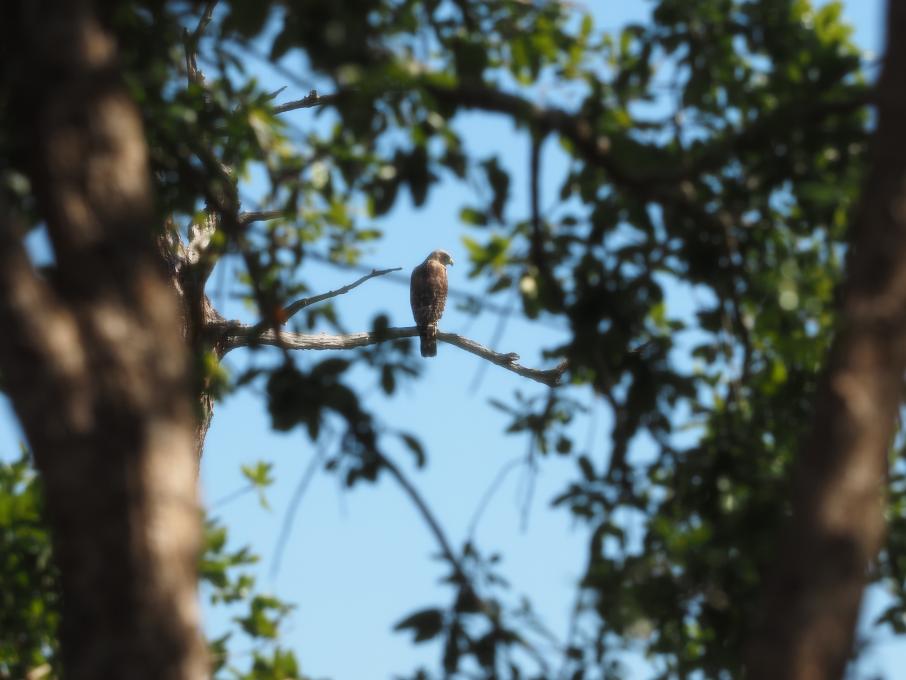 Bird ID Activity 1: This is a photo from last year just after I got my 40-150 sense for Olympus. I think this is a coopers hawk from my previous searches through the bird guides that I have. It is a juvenile that I saw hunt in the neighborhood a few times. A feature not captured in a photo is its fan shaped tail that appears white with black stripes, ie the white is 50% broader than the black on the tail. Merlin from my descriptions suggests a red shouldered hawk is more likely in Florida.
Pertinent to this exercise though, another bird hunts in the neighborhood as well. It is a little smaller with a long forked tail. It is a swallow tailed kite. I don't have a good picture but once you have seen one fly nearby, it is impossible not to recognize.
Bird ID Activity 1: This is a photo from last year just after I got my 40-150 sense for Olympus. I think this is a coopers hawk from my previous searches through the bird guides that I have. It is a juvenile that I saw hunt in the neighborhood a few times. A feature not captured in a photo is its fan shaped tail that appears white with black stripes, ie the white is 50% broader than the black on the tail. Merlin from my descriptions suggests a red shouldered hawk is more likely in Florida.
Pertinent to this exercise though, another bird hunts in the neighborhood as well. It is a little smaller with a long forked tail. It is a swallow tailed kite. I don't have a good picture but once you have seen one fly nearby, it is impossible not to recognize.
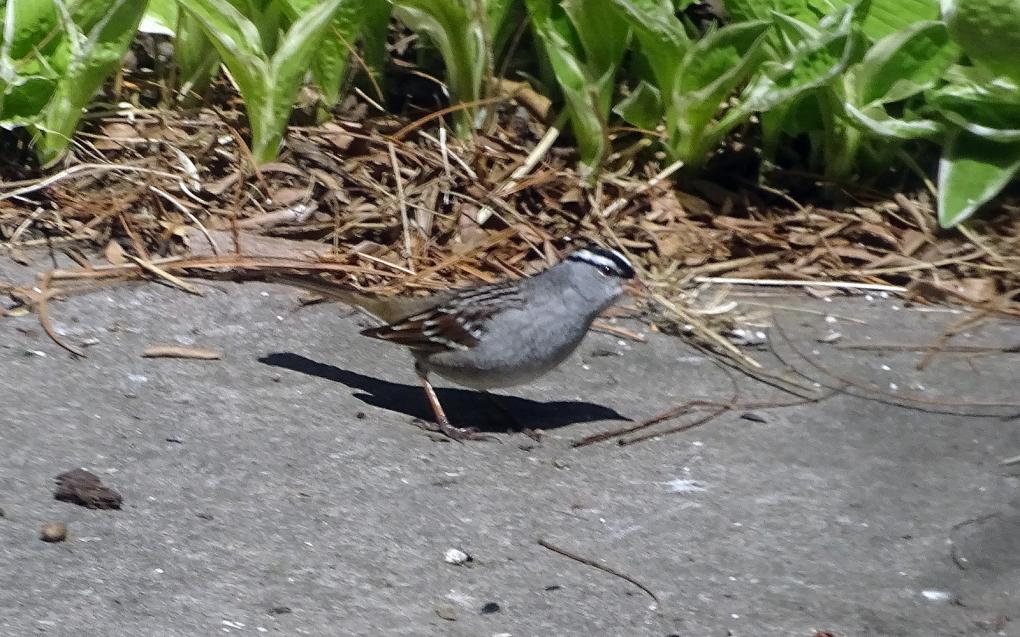
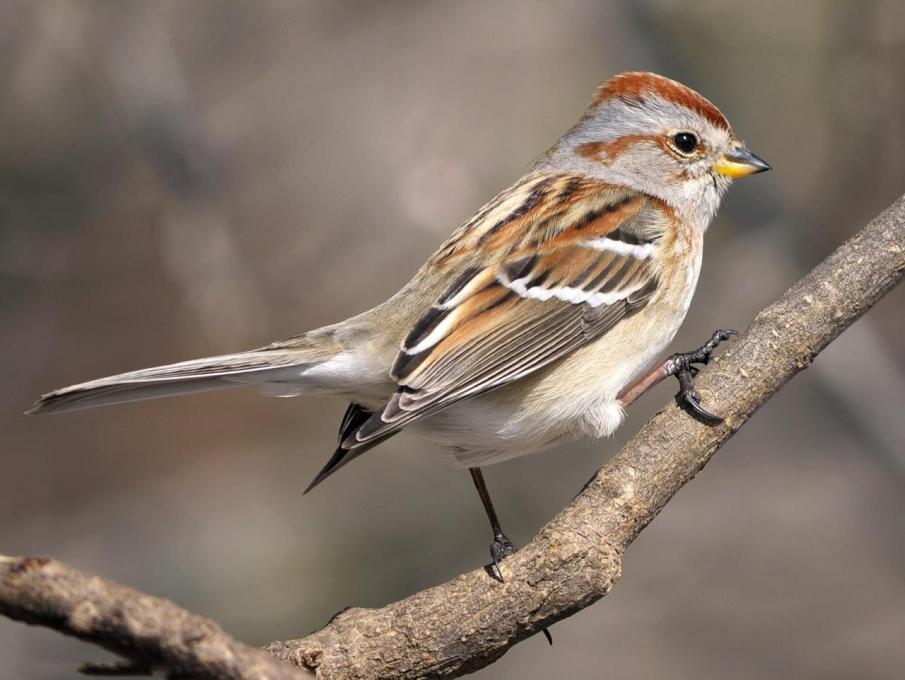 Chipping Sparrow
Chipping Sparrow
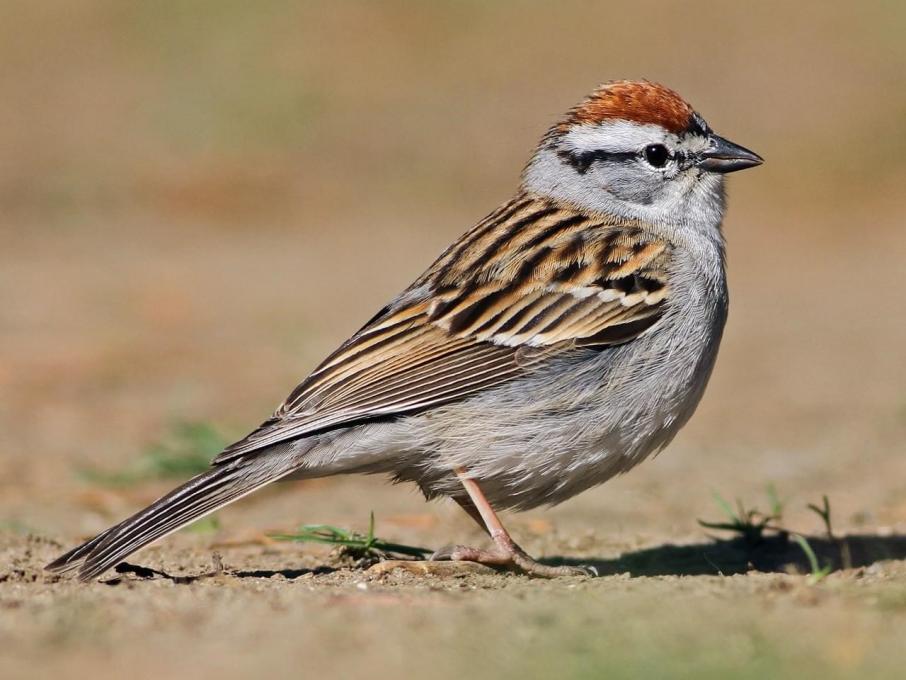 Field Sparrow
Field Sparrow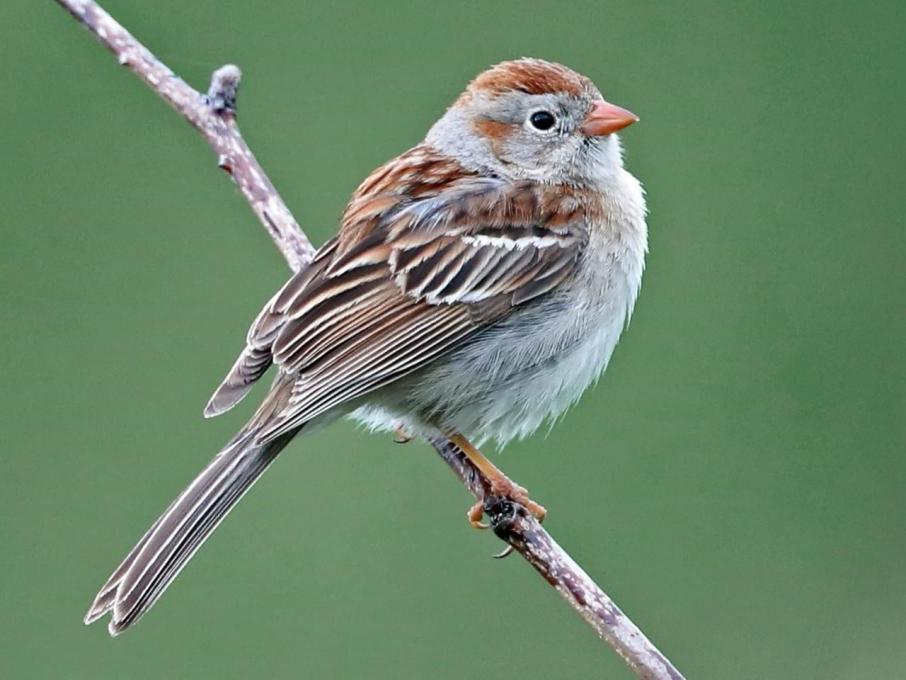
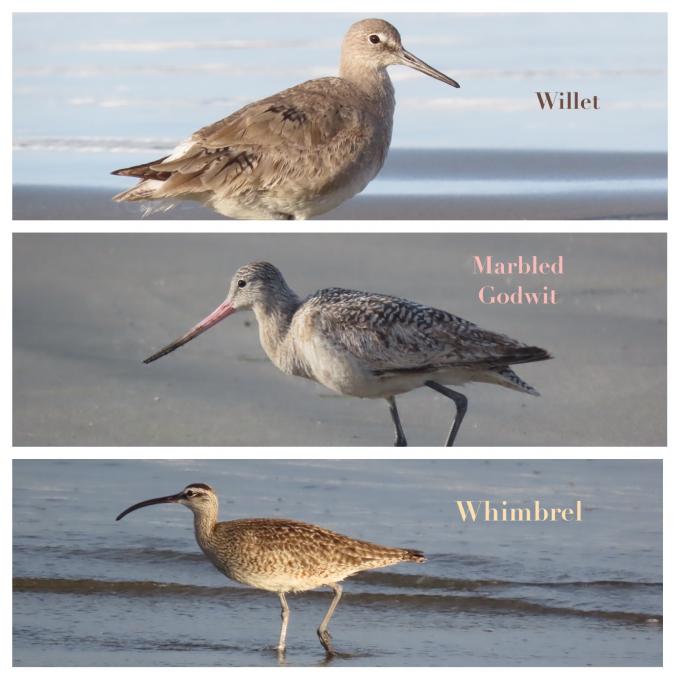 Activity 1: I have been trying to sort in my own mind how to tell these three shorebirds apart, so yesterday I went out with my camera to an empty beach at 7:00 in the morning. Their body shape and coloring look pretty similar to my untrained eye, at least from a distance. Their bills are distinctively different, the Whimbrel's is curved down, the Willit's is much shorter and the Godwit's is longer with an apricot colored part. The Willit is easy to identify when it is flying because it has a distinctive white band on it's wings, the Whimbrel has a stripe on it's head. Now I just have to remember which is which.
Activity 1: I have been trying to sort in my own mind how to tell these three shorebirds apart, so yesterday I went out with my camera to an empty beach at 7:00 in the morning. Their body shape and coloring look pretty similar to my untrained eye, at least from a distance. Their bills are distinctively different, the Whimbrel's is curved down, the Willit's is much shorter and the Godwit's is longer with an apricot colored part. The Willit is easy to identify when it is flying because it has a distinctive white band on it's wings, the Whimbrel has a stripe on it's head. Now I just have to remember which is which. ![20200428_073630[1]](https://academy.allaboutbirds.org/wp-content/uploads/hm_bbpui/697288/Tghqph4uisty4lex6k89pdlaijal5lc5z.jpg)
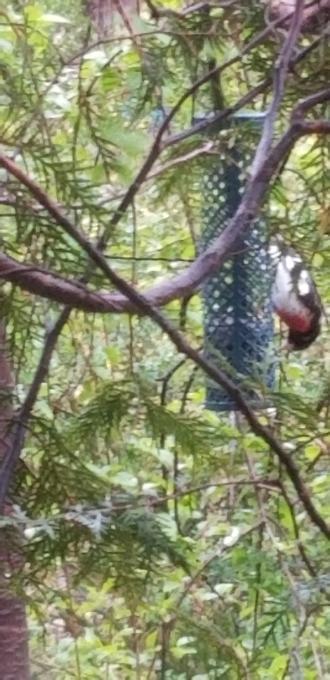
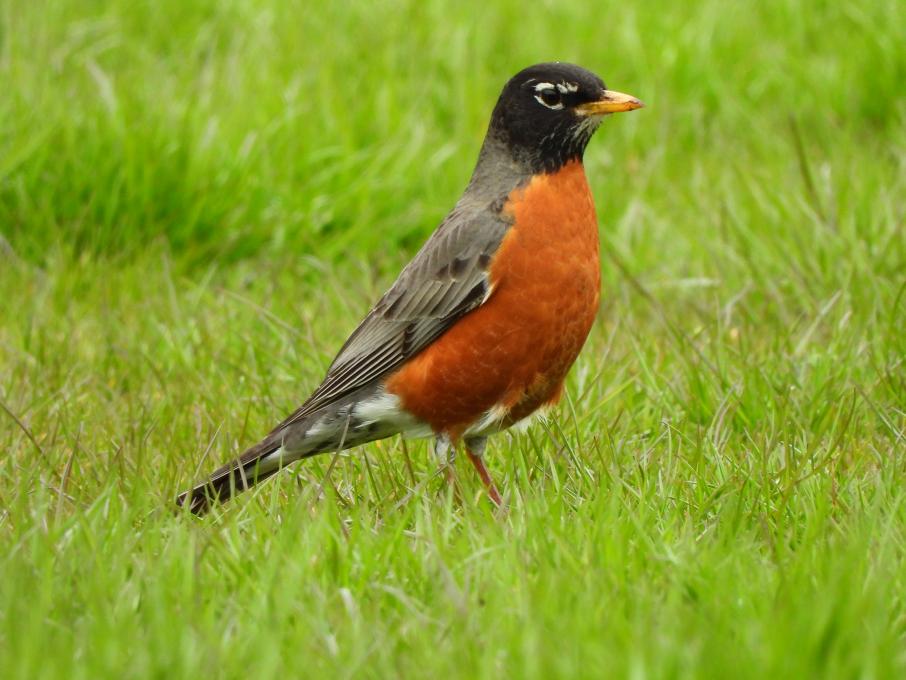
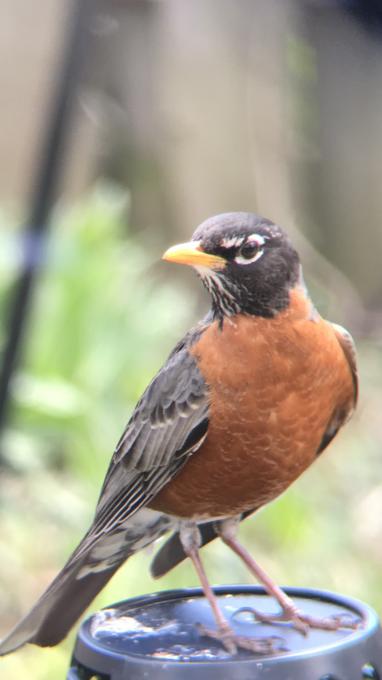 Goldfinch- sparrow sized or smaller, small head, long wings, short notched tail, small conical beak
Goldfinch- sparrow sized or smaller, small head, long wings, short notched tail, small conical beak
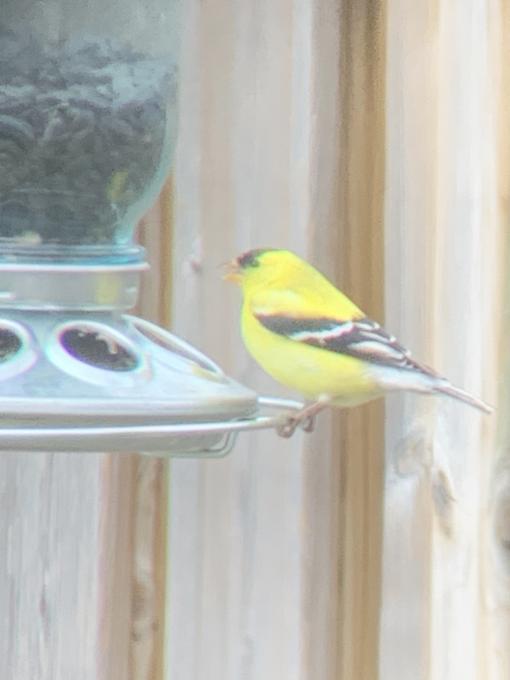
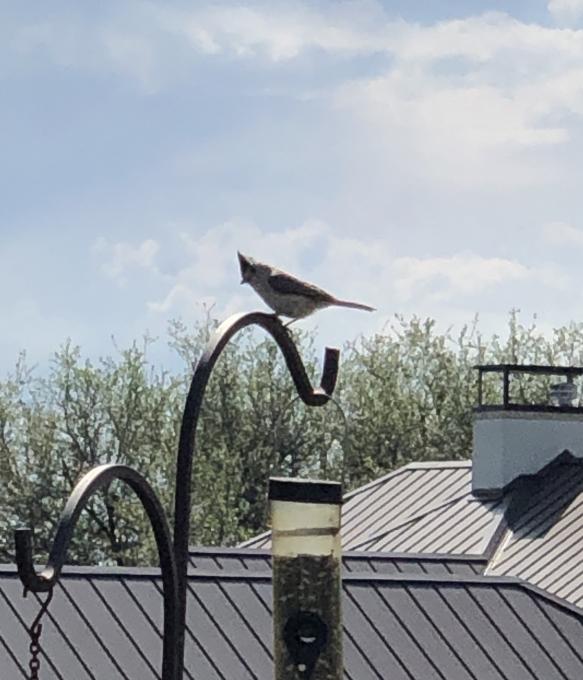 saw a Black Crested Titmouse at the feeder taking one seed at a time and flying back to the tree to eat it (I guess) and going back and forth many times. A cardinal ate at the feeder and also foraged on the ground below the feeder for seeds. In Iowa, I watched Bald Eagles fishing in the Mississippi, diving low towards the water with their talons out and catching the fish in flight flying away with the fish in its talons. Activity 4. Favorite bird-Northern Cardinal. Id'ed by its size and shape (larger than a robin with a distinctive crest), color pattern and markings ( the black around its eyes contrasting wit the red is so pretty), sounds (today, the female was chirping just like the Merlin app example; They also often sing more elaborate songs.) I love the Merlin app having so many examples of each bird's songs. It really helps me learn them!
saw a Black Crested Titmouse at the feeder taking one seed at a time and flying back to the tree to eat it (I guess) and going back and forth many times. A cardinal ate at the feeder and also foraged on the ground below the feeder for seeds. In Iowa, I watched Bald Eagles fishing in the Mississippi, diving low towards the water with their talons out and catching the fish in flight flying away with the fish in its talons. Activity 4. Favorite bird-Northern Cardinal. Id'ed by its size and shape (larger than a robin with a distinctive crest), color pattern and markings ( the black around its eyes contrasting wit the red is so pretty), sounds (today, the female was chirping just like the Merlin app example; They also often sing more elaborate songs.) I love the Merlin app having so many examples of each bird's songs. It really helps me learn them! 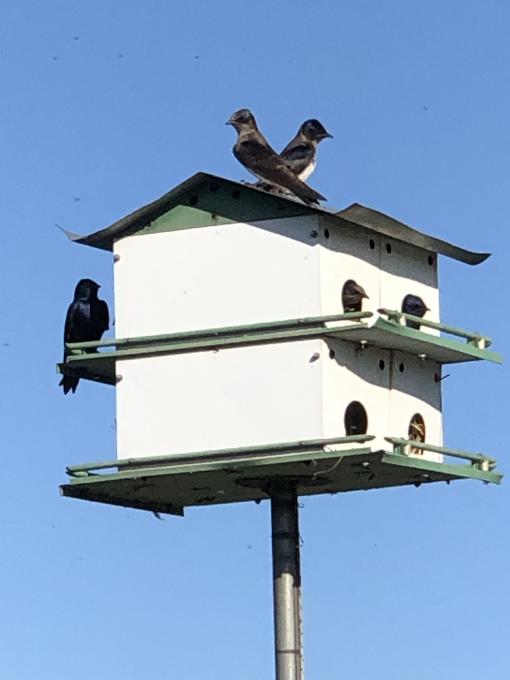 Activity 1. 2 birds of different shape. At my feeder today I saw a female cardinal with the characteristic crest on her head. She had barely noticeable red on her wings and tail. Also, a house sparrow with the small size, no tuft or crest. Sparrows seem to usual but he was very pretty with his intricate wing colorings! Activity 2. 3 birds-same color on diff parts of body . My color is black: Purple Martins-Identifiable with the forked tail and shape of beak The habitat/behavior of using a raised martin house. House Sparrow (again)-identified by his color pattern, behavior at the feeder and size and shape. Great Blue Heron-identified by his habitat on the water and color pattern. I identified all through Merlin. What a great app!!
Activity 1. 2 birds of different shape. At my feeder today I saw a female cardinal with the characteristic crest on her head. She had barely noticeable red on her wings and tail. Also, a house sparrow with the small size, no tuft or crest. Sparrows seem to usual but he was very pretty with his intricate wing colorings! Activity 2. 3 birds-same color on diff parts of body . My color is black: Purple Martins-Identifiable with the forked tail and shape of beak The habitat/behavior of using a raised martin house. House Sparrow (again)-identified by his color pattern, behavior at the feeder and size and shape. Great Blue Heron-identified by his habitat on the water and color pattern. I identified all through Merlin. What a great app!! 